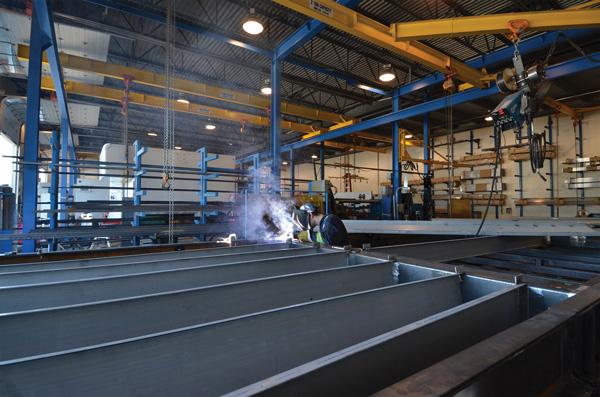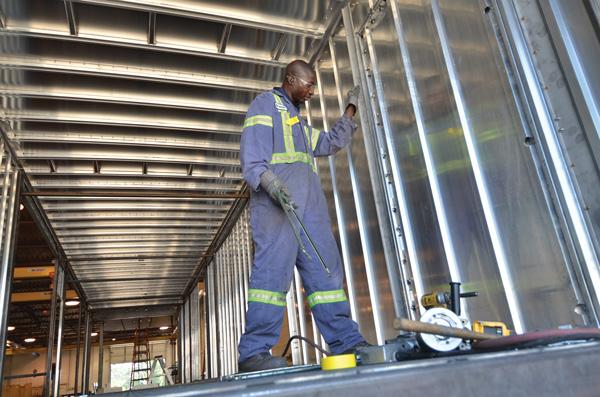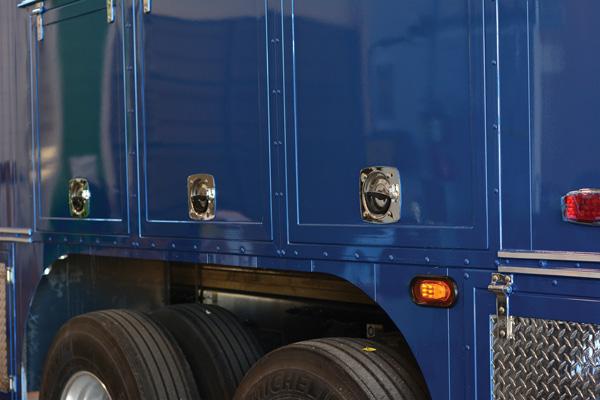- FMA
- The Fabricator
- FABTECH
- Canadian Metalworking
It's a Snap
ITB builds custom truck bodies, trailers, and enclosures with an extruded aluminum build system
- By Sue Roberts
- October 6, 2014
- Article
- Made In Canada

(left to right) Phil Van Dyke, operations manager; John Van Seters, sales and marketing manager; and Nathan Van Seters, general manager, Intercontinental Truck Body, Surrey, B.C., are inside a custom-outfitted van.
Intercontinental Truck Body (ITB) has a simple formula to keep employees at its manufacturing facilities from getting bored. For the builder of custom truck bodies, trailers, and enclosures, the quantity order for the majority of projects is one. Projects are designed from the ground up, and the company handles everything in-house, including body construction, interior finishing, electrical outfitting, component integration, and exterior painting.
Variety is constant. A prisoner transport vehicle might be followed by a truck that will haul live baby chickens. A fully equipped fire rescue apparatus could be followed by a personalized recreational vehicle or by a lightweight parcel delivery van. Likewise, a film production trailer might be followed by an electrical enclosure for use in the oil sands.
Western Canada is home for the majority of ITB’s products but some, particularly oil patch equipment and remote equipment shelters, have made their way to South America, Antarctica, the Middle East, China, Russia, and even Australia. Project invoicing varies from as low as $10,000 for a cargo van to as high as $600,000 for a command post vehicle outfitted with stand-alone power, satellite communication equipment, and everything required to house first responders in an emergency situation.
Regardless of the final product, the starting point is the same: the customer’s ideas.
A Different Twist
Coaldale, Alb., was the location of ITB’s first manufacturing plant, which opened in 1974. Offices in Edmonton and Calgary, and the addition of the new manufacturing plant in Surrey, B.C., in 1986 helped service the rapidly expanding market. By the early 2000s, opportunities across the southern border brought ITB together with U.S. partners to establish Tri- Van Truck Body in Ferndale, Wash. The three facilities have a combined 120,000 sq. ft. of manufacturing space on 20 acres of land.
Housing contractors and brothersin- law Peter Van Seters and Aren Van Dyke became partners when ITB expanded from Alberta to British Columbia. A unique concept for building aluminum truck bodies had been developed by Peter’s father, Jake Van Seters, and his brothers Neil and Hugo. Forty years later, their original extruded aluminum snap-lock panel design is still at the heart of ITB’s ultradurable, lightweight, and customizable build system.
Peter and Aren have both retired, and day-to-day company management is now in the hands of the next generation. Nathan Van Seters, general manager; John Van Seters, sales and marketing manager; and Phil Van Dyke, operations manager, now lead the British Columbia plant, and business has grown steadily under their watch.
Nathan explained the company structure: “Each location is a separate entity but we work cooperatively. We operate as a buying group and can do cross-house work. If one facility gets a big contract, we can draw on other facility resources to help deliver.”
Most products can be built at any of the plants, although each has specialized to some degree. “The geographic locations have different requirements,” said John. “Our Alberta plant has specialized in satisfying the unique requirements of the oil patch. In British Columbia we focus more on government contracts and the movie industry. Over the years our facilities have developed some different skill sets, but at the end of the day, all of our facilities are building trucks, trailers, and enclosures in the same way.”

Wall sections for truck bodies, trailers, and enclosures are constructed from a patented, time-saving snap-lock panel system made from aluminum extrusions.
Projects like mobile research labs and municipal crew vehicles are human workspaces, while other trucks, trailers, and enclosures house industrial equipment, like generators for backup power at a hospital, or natural gas compressors for filling CNG vehicles. Whether for people or for machinery, these complex mobile units share a need for custom fabricated furnishings, suitable heating and cooling, robust power supply and distribution, and a variety of supporting electrical subsystems.
Creativity Is on Call
Each project starts with the customer’s idea whether it’s a fully developed specification or a preliminary sketch.
“When it’s just a few thoughts and a sketch, then we get to be creative,” said John. “We start by figuring out the best platform; the size and type of truck, trailer, or enclosure. Then we work within the physical space to design the most productive workspace or equipment layout that will fit within the customer’s budget. We always bring in ideas from previous jobs, but every project is an evolution … an improvement from something we’ve done in the past. We give the customer a starting point and from there we adapt, tweak, and make sure everything is compliant with current laws and standards.”
John added, “We work with people who know exactly what they want, but we also work with dreamers because every big idea starts somewhere.” He cited the film industry vehicle as a dream gone big: “On ITB’s opening day, a fellow came in with the idea of building a vehicle specific to the growing Vancouver film industry. That type of vehicle didn’t exist 25 years ago when we started working with him, but now there are dozens of them in service, and he is one of the biggest players in that market.”
Design data is shared among all facilities so each plant can build upon existing plans. Different ideas are pulled from different industries to enhance designs. That ability sets ITB apart from its competitors that typically specialize in one type of vehicle.
“We’ll be building something for the movie industry and think it will be a good fit with an emergency response vehicle. It might be a new type of lighting or an ergonomic design for a workspace,” said John. “Most specialized companies don’t have opportunities to see what ideas are emerging in other industries so they don’t get to share in the crossflow of design ideas.”
Lower Labor Costs
Although sheet metal fabrication still has an important place on ITB’s shop floor, the heart of their unique build system is aircraft-grade aluminum extrusions. The company’s proprietary snap-lock wall panel system forms self-framing walls that have the thickness and strength to accommodate complex features like windows and doorways. Various other interlocking extrusions are used for corners, roof structures, doors, and even flooring.
“Rather than turning sheet metal into shapes for framing our units, we create new extrusions. Our competitors spend more time cutting, forming, and attaching sheet metal. We create extrusions that fit together with minimum effort,” said John. “This translates into higher material cost but less assembly labor. In the last 25 years as the cost of labor has gone up faster than the price of aluminum, our build system has become even more compelling.”
Proprietary 6-in. and 12-in. wall panels are snapped together to form the all-aluminum self-framing walls in just a couple of hours. These walls are then bolted to a steel or aluminum subframe in an overlapping manner to protect against corrosion and water penetration. The aluminum roof also overlaps the walls for a weather seal. The few fasteners that are required to attach the roof and doors to the walls are permanent HuckBolts®.
Then the customization begins with the addition of custom metal fabrications, storage compartments, woodwork, plumbing, lighting, climate control, and whatever features and support systems the customer requires. Purchased components like generators, electrical panels, and lighting are incorporated into the overall design.
Bringing these projects from design to reality takes a team of seasoned fabricators, welders, electricians, and other tradespeople. “Unlike many other manufacturers, ITB’s project workflow combines welding, fabricating, and installation in a single position. Typically, employees handle their own sheet metal work,” John said. “They will cut it to size, take it to the bench, weld it, and typically install it in the unit. Our production is very project-focused, which makes it challenging but also very rewarding.”
CNC press brakes and shears are the primary pieces of fabricating equipment at ITB. Drill presses, band saws, tube benders, and ironworkers round out the equipment roster for varied applications. According to Nathan, “We do some woodwork in terms of the interior lining of units, but we’re primarily a metal and electrical shop. We stay with our core competencies and work with good suppliers in areas where we don’t specialize.”
Welding is primarily gas metal arc welding, but some gas tungsten arc welding is involved. Many bodies end up being built entirely of aluminum; however, a fair amount of steel work is involved when large, heavy structural weldments are used to provide a base frame. These frames typically require flux-cored arc welding or metal-cored arc welding and the shop is CWB-certified for enclosure frames and trailers.
Revamping the Old
After 25 years of service, many units are now returning for updating, refreshing, or to be upgraded to meet new requirements.
“The lack of built-in obsolescence is an ironic shortfall for our company,” said Nathan. “We didn’t do a very good job on the engineer-to-fail part. Units come back for a refurbishment cycle where we strip out the interior, redo what is needed, and give them a fresh coat of paint. They return to the field as almost-new products at a cost much lower than building new units. We regularly reinstall used bodies on new chassis, and we’ve had plenty of truck bodies that have outlived three or more trucks.”
ITB’s shop floor project emphasis can make hiring a challenge as there are very few assembly line-type positions. Skilled workers are required, but are not always available, so the company is focused on training. ITB cycles its employees through welding programs at Kwantlen Polytechnic University and the metal fabricating program at British Columbia Institute of Technology. The company continually works with young people coming out of school who are looking for further education and provides apprenticeship opportunities in fabricating, welding, paint preparation, and electrical wiring.
“We would love to hire people tomorrow who have all the skills we need, but that’s not the reality and probably never was,” said Nathan. “To have good employees you’d better be prepared to invest in them.”
Nathan said that he sees a refreshing overall shift in attitude toward manufacturing—from the government to local schools to media—that he hopes will lead to more young people entering the trades. “We are oversupplying the marketplace with expensive educations that aren’t really beneficial, and that leads to people working in jobs that aren’t the best fit for them. I see the pendulum coming back to where there is a viable future for the trades.
“We’ve worked hard to get a good crop of young people in the shop so we don’t have to worry about having a workforce that will all be retiring in the next few years.”
More Locations—Maybe
Will there be a next generation of ITB leaders? “Our parents had a vision of a family business as an opportunity for their kids to learn how to work,” said Nathan. “There was never the expectation that we had to be in the business, but some of us have ended up here anyway. I was on a very different career track but I came back and it has been very rewarding.”
John and Phil also had other intentions. John said, “When you’re in university, the last thing you think about is ending up in the business that you grew up with. We both worked in different companies but came back to the family business because we saw how we could directly impact the organizational culture and direction. As a family-run company, ITB is built on a strong set of faith-based principles, and we enjoy working within that servant leadership framework.”
There is a strong possibility for other ITB facilities in the future, and although today’s leaders won’t impose career expectations on their children, they would be pleased to have them step in to continue the company’s growth and success.
“Our kids are still quite young, but some of our partners’ kids are hitting their teenage years and making choices about their schooling,” said Nathan. “We should start having more serious conversations about what the next phase of our business might look like.”
subscribe now


Keep up to date with the latest news, events, and technology for all things metal from our pair of monthly magazines written specifically for Canadian manufacturers!
Start Your Free Subscription- Trending Articles
- Industry Events
ZEISS Quality Innovation Days 2024
- April 15 - 19, 2024
Tube 2024
- April 15 - 19, 2024
- Düsseldorf, Germany
CTMA Economic Uncertainty: Helping You Navigate Windsor Seminar
- April 30, 2024
- Windsor, ON Canada
MME Winnipeg
- April 30, 2024
- Winnipeg, ON Canada
CTMA Economic Uncertainty: Helping You Navigate Kitchener Seminar
- May 2, 2024
- Kitchener, ON Canada

















